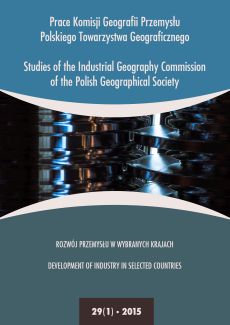Transformation of the spatial structure of the Mexican automotive industry under the impact of FDI
DOI:
https://doi.org/10.24917/20801653.291.1Keywords:
automotive industry, Foreign Direct Investments, industrial location, Mexico, regional developmentAbstract
The purpose of this article is to determine the impact of FDI on the changes in the spatial distribution of the automotive industry in the years 1999-2013. The article examines the spatial structure of FDI inflows associated with the automotive industry to Mexican states, trying to determine their size and structure as well as their impact on the change in the level of employment and production in this sector. The analysis allowed for indicating the newly formed clusters of this industry in the analyzed states. In the years 1999-2013, the Mexican automotive industry attracted the inflow of more than USD30.4 billion in the form of FDI, which accounted for 8.5% of the total cumulative value of FDI inflow in this period. This led in consequence to the dynamic growth of the production of new vehicles as well as parts, most of which was spent on export to neighboring countries of NAFTA. One of the important elements of the transformation of the Mexican economy in the early 1990s. was the liberalization of foreign trade and the opening of the inflow of foreign investment. The second very important economic advantage was joining NAFTA in 1994. Those two factors caused Mexico to become a very attractive place for the location of industrial activities. Firstly, due to its large domestic market, growing with the increase in wealth of the society. Secondly, due to the NAFTA agreement guaranteeing the freedom of movement of goods to the USA and Canada meant that Mexico was becoming an attractive production platform offering relatively cheap and well-educated workforce and access to capacious market. Another important factor increasing the inflow of FDI, particularly in the automotive industry, was connected with changes of the strategies of the international car producers under the influence of globalization and increasing competition in global markets. The desire to reduce production costs while maintaining the quality of the produced vehicles and access to the market, have forced particularly American corporations (GM, Ford and Chrysler) to transfer an increasing part of their production to Mexico. The country has also become attractive to other transnational corporations competing with American manufacturers, which also intensified FDI inflow in this sector to Mexico.
Downloads
Metrics
References
Bennett, D., Sharpe, K. (1984). Agenda Setting and Bargaining Power: The Mexican State versus Transnational Automobile Corporations. W: R. Kronish, K.S. Mericle (red.). The Political Economy of the Latin American Motor Vehicle Industry, Cambridge-London: MIT Press, 195– 229.
Calderón, A., Mortimore, M., Peres, W. (1996). Foreign investment as a source of international competitiveness. W: J.H. Dunning, R. Narula (red.). Foreign direct investment and governments. Catalysts for economic restructuring. London–New York: Routledge, 188–219.
Carrillo, J. (1991). Restructuración en la industria automotriz en México. Estudios Sociológicos, 9(27), 483–525.
Carrillo, J. (1997). Maquiladoras automotrices en México: Clusters y competencias de alto nivel. W: M. Novick, M. Gallart (red.). Competitividad, redes productivas y competencias laborales. Montevideo: OIT/CINTERFORD/Red Educación y Trabajo, 193–234.
Carrillo, J. (2000). The integration of the Mexican Automobile Industry to the USA: between polices and corporate strategies. Actes du GERPISA, 28, 55–77.
Carrillo, J. (2004). NAFTA: The Process of Regional Integration of Motor Vehicle Production. W: J. Carrillo, Y. Lung, R. van Tulder (red.). Cars, Carriers of Regionalism? Houndmills-New York: Palgrave Macmillan, 104–117.
Carrillo, J., Hualde, A., Quintero, C. (2005). Maquiladoras en México. Breve recorrido histórico.Comercio Exterior, 55(1), 30–42.
Censos Económicos 1999 (1999). Mexico D.F.: Instituto Nacional de Estadística y Geografía – INEGI. Pozyskano z http://www.inegi.org.mx/est/contenidos/proyectos/ce/ce1999/default.aspx.
Censos Económicos 2009 (2009). Mexico D.F.: Instituto Nacional de Estadística y Geografía – INEGI, Mexico. Pozyskano z http://www.inegi.org.mx/est/contenidos/espanol/proyectos/censos/ce2009/ default.asp?s=est&c=14220.
Contreras, O.F., Carrillo, J., Alonso, J. (2012). Local Entrepreneurship within Global Value Chains: A Case Study in the Mexican Automotive Industry. World Development, 40(5), 1013–1023.
Covarrubias, A.V. (2011). NThe Mexican Auto Industry: From Crisis to Greater Region-centric Influence. orteamerica, 6(2), 115–155.
Czerny, M. (1994). Restrukturyzacja przemysłu i rozwój regionalny Meksyku. Studia i Materiały, 13, Warszawa: Centrum Studiów Latynoamerykańskich Uniwersytetu Warszawskiego.
Dorocki, S. (2010). Współczesne procesy internacjonalizacji produkcji i delokalizacji przemysłu samochodowego Francji. Prace Komisji Geografii Przemysłu Polskiego Towarzystwa Geograficznego, 16, 125–136.
Dorocki, S., Brzegowy, P. (2014). The maquiladora industry impact on the social and economic situation in Mexico in the era of globalization. W: M. Wójtowicz, A. Winiarczyk-Raźniak (red.). Environmental and socio-economic transformations in developing areas as the effect of globalization. Kraków: Wydawnictwo Naukowe Uniwersytetu Pedagogicznego, 93–110.
Encuesta Anual de la Industria Manufacturera (2013). Mexico D.F.: Instituto Nacional de Estadística y Geografía – INEGI. Pozyskano z http://www.inegi.org.mx/sistemas/bie/default.aspx.
Estadística oficial de los flujos de IED hacia México (2014). Mexico D.F.: Secretaría de Economía. Pozyskano z http://www.economia.gob.mx/comunidad-negocios/competitividad-normatividad/ inversion-extranjera-directa/estadistica-oficial-de-ied-en-mexico Grupo de Trabajo de Estadísticas de Comercio Exterior, integrado por el Banco de México (2014).
Mexico D.F.: Instituto Nacional de Estadística y Geografía – INEGI. Pozyskano z http://www.inegi.org.mx/sistemas/bie/default.aspx.
Łasak, P. (2013). Procesy umiędzynarodowienia przemysłu samochodowego. Rola rynków wschodzących. Kraków: Wydawnictwo Uniwersytetu Jagiellońskiego.
Miranda, A.V. (2007). La industria automotriz en México. Antecedentes, situación actual y perspectivas.Contaduría y Administración, 221, 211–248.
Moreno-Brid, J.C., Santamaria, J., Rivas Valdivia, J.C. (2005). Industrialization and Economic Growth in Mexico after NAFTA: The Road Travelled. Development and Change, 36(6), 1095–1119.
The Automotive Industry (2013). Ministry of Economy, ProMéxico Trade and Investment, Business Intelligence Unit, Mexico D.F. Pozyskano z http://www.promexico.gob.mx/work/models/promexico/ Resource/447/1/images/120731_FC_The%20Automotive%20Industry_EN.PDF.
Wójtowicz, M. (2011). Wpływ światowego kryzysu gospodarczego na brazylijski i meksykański przemysł samochodowy. Prace Komisji Geografii Przemysłu Polskiego Towarzystwa Geograficznego, 17, 129–143.
Wójtowicz, M. (2012). Rozwój i przekształcenia przemysłu samochodowego w Brazylii i Meksyku na przełomie XX i XXI wieku. W: M. Drgas, J. Knopek (red.). Gospodarcze problemy Ameryki Łacińskiej. Toruń: Wydawnictwo Adam Marszałek, 161–193.
Wójtowicz, M., Rachwał, T. (2014). Globalization and New Centers of Automotive Manufacturing – the Case of Brazil, Mexico, and Central Europe. Prace Komisji Geografii Przemysłu Polskiego Towarzystwa Geograficznego, 25, 81–107.
Downloads
Published
How to Cite
Issue
Section
License
Articles are published under the terms of the Creative Commons License (CC BY-ND 4.0; Attribution– NoDerivs).

